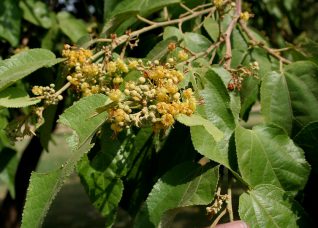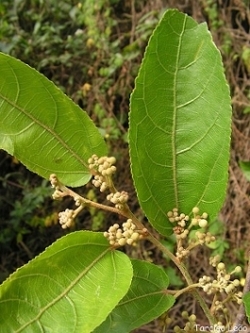
MinerAlert

MinerAlert
Guazuma ulmifolia
Malvaceae
Ajillá, Bastard cedar, Gunstock, Hay cedar, Jackocalaloo, Pricklenut, Bois De L’Orme, Bois de hetre, Bwa Dom, Guazuma, Guácima, Cuaulote, Caulote, Contamal, Huásimo, Mawo baba, Moena, Mutamba, Papayillo, Pixoy.

Bolaina negra, Bolita, Cabeza de negro, Cabeza de negrito, Caca de mico, Coco, Cerezo, Guácimo blanco, Guácimo cimarrón, Guácimo de caballo, Guácimo dulce, Guácimo de ternero, Llucho vainilla, Majagua de toro, Tablote, Yaco de granadillo, Yaco de venado.
The leaves, bark, root, flowers, and fruit.
This medium-size to tall tree grows in the tropical and subtropical regions Mexico, as well as Latin America (including some Caribbean countries), and India.

Photo: Tarciso Leão - Google images
Leaves of G. ulmifolia
Before you decide to take any medicinal herb or herbal supplement, be sure to consult with a health care professional first. Avoid self-medication and self-diagnosis: Always be on the safe side!
Adame J, Adame H. Plantas Curativas del Noreste Mexicano.
Monterrey, N.L.: Ediciones Castillo; 2000; pp. 109-110.
Argueta A. Atlas de las Plantas de la Medicina Tradicional Mexicana Vol.2.
Mexico City: Instituto Nacional Indigenista; 1994; pp. 717-718.
Caceres A, Cano O, Samayoa B, Aguilar L. Plants used in Guatemala for the treatment of
gastrointestinal disorders. Screening of 84 plants against enterobacteria.
J Ethnopharmacol. 1990;30(1):55-73.
Calixto Júnior JT, de Morais SM, Gomez CV, Molas CC, Rolon M, Boligon AA, Athayde ML,
de Morais Oliveira CD, Tintino SR, Henrique Douglas MC. Phenolic composition and
antiparasitic activity of plants from the Brazilian Northeast "Cerrado".
Saudi J Biol Sci. 2016; 23(3):434-40. doi: 10.1016/j.sjbs.2015.10.009.
Castrejón-Pineda F, Martínez-Pérez P, Corona L, Cerdán JL, Mendoza GD. Partial substitution
of soybean meal by Gliricidia sepium or Guazuma ulmifolia leaves in the rations of growing
lambs. Trop Anim Health Prod. 2016;48(1):133-7.
Jacobo-Salcedo Mdel R, Alonso-Castro AJ, Salazar-Olivo LA, Carranza-Alvarez C, González-
Espíndola LA, Domínguez F, Maciel-Torres SP, García-Lujan C, González-Martínez Mdel R,
Gómez-Sánchez M, Estrada-Castillón E, Zapata-Bustos R, Medellin-Milán P, García-Carrancá
A. Antimicrobial and cytotoxic effects of Mexican medicinal plants. Nat Prod Commun. 2011
;6(12):1925-8.
Johnson T. CRC Ethnobotany Desk Reference.
Boca Raton, FL: CRC Press; 1999; p. 386.
Kaneria M, Baravalia Y, Vaghasiya Y, Chanda S. Determination of antibacterial and antioxidant
potential of some medicinal plants from saurashtra region, India. Indian J Pharm Sci.
2009;71(4):406-12. doi: 10.4103/0250-474X.57289.
Languefosse JL. Plantes Medicinales Caribeennes.
Paris: Editions Orphie; 2007; pp. 54-55.
Liogier HA. Diccionario Botánico de Nombres Vulgares de la Española.
Santo Domingo: UNPHU; 1974: p. 395.
Liogier, AH. Plantas Medicinales de Puerto Rico y el Caribe.
San Juan, PR: 1990; pp. 249-251.
Lopes GC, Longhini R, Dos Santos PV, Araújo AA, Bruschi ML, de Mello JC. Preliminary
Assessment of the Chemical Stability of Dried Extracts from Guazuma ulmifolia Lam.
(Sterculiaceae). Int J Anal Chem. 2012; 2012:508945. doi: 10.1155/2012/508945.
Mabberley D. Mabberley’s Plant Book 3rd ed.
London: Cambridge University Press; 2008; p. 378.
Martínez M. Las Plantas Medicinales de México.
México, D.F.: Editorial Botas; 1989; pp. 157-158.
Martínez M. Catálogo de Nombres Vulgares y Científicos de Plantas Mexicanas.
México, D.F.: Fondo de Cultura Económica; 1994; p. 1125.
Mendoza-Castelán G, Lugo-Pérez R. Plantas Medicinales en los Mercados de México.
Chapingo, Estado de México: Universidad Autónoma Chapingo; 2011; pp. 428-429.
Nuñez-Meléndez, E. Plantas Medicinales de Puerto Rico.
San Juan, PR: Editorial Universitaria de Puerto Rico; 1982; pp. 190-191.
Pittier H. Manual de Plantas Usuales de Venezuela y Su Suplemento.
Caracas: Fundación Eugenio Mendoza; 1971; p. 240.
Quattrocchi, U. World Dictionary of Medicinal and Poisonous Plants (Vol. 3).
Boca Raton, FL: CRC Press; 2012; pp. 393-394.
Safwat AM, Sarmiento-Franco L, Santos-Ricalde RH, Nieves D. Determination of tropical
forage preferences using two offering methods in rabbits. Asian-Australas J Anim Sci. 2014
;27(4):524-9. doi: 10.5713/ajas.2013.13163.
Sánchez-Monge E. Diccionario de Plantas de Interés Agrícola Vol. 1.
Madrid: Ministerio de Agricultura; 2001; pp. 516-517.
Torkelson A. The Cross Name Index to Medicinal Plants. Vol. 3.
Boca Raton, FL.: CRC Press; 1996; p. 1003-1004.
Vallejo, M.A., and F.J. Oveido. 1994. Características botánicas, usos y distribución de los
principales árboles y arbustos con potencial forrajero de América Central. In: Árboles y arbustos
forrajeros en América Central. Volumen 2. Serie Técnica, Informe Técnico N° 236. Centro
Agronómico Tropical de Investigación y Ensenañza (CATIE). Turrialba, Costa Rica; pp. 676-
677.
White R. Elsevier’s Dictionary of Plant Names of North America Including Mexico.
Amsterdam: Elsevier; 2003; p. 91.